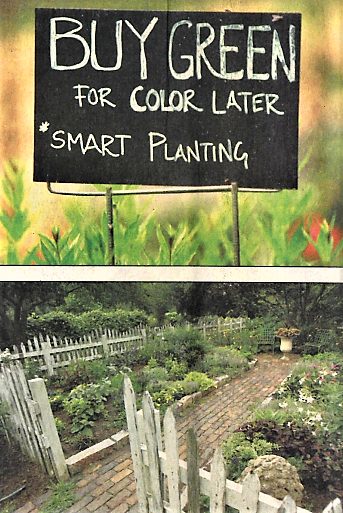Know Maintenance: The Northwind experience isn't just about planting
By Catherine W. ldzerda – Jansville 2009
A garden center sells plants. North wind Perennial Farm sells plants. Ergo, Northwind Perennial Farm is a garden center. In this case, the logic doesn't work. It would be more accurate to say Northwind is a botanical garden that promotes the idea of living more peacefully with your gardening duties.
Northwind is located on an old dairy farm north of Lake Geneva. Visitors turn onto a gravel drive, crunching past a barn and a series of ancient out buildings that serve as informal shops for garden-related antiques and other items. An old coop still is home to a collection of heirloom hens and roosters. Occasionally, the chickens make a trip into the yard.
Ignoring visitors, they scratch and peck for grubs and grit, sometimes taking dirt baths in the dry soil at the base of the shrubs. Then there are the gardens.
Looping throughout the grounds and informally connected with a series of meandering paths, the gardens include ponds, prairie-like fields and shady glens. Experienced gardeners will recognize most of the plants. They include common and uncommon varieties of coreopsis, Echinacea, baptisia, salvia, penstemon, sedum, yarrow, allium, perennial geranium, Veronica, hosta and grasses. Wild roses, evergreens and deciduous trees dot the landscape, providing focal points and adding texture. The landscape looks both wild and cohesive-a tricky combination that often confounds long-time gardeners. Plants are sold at the center of the property near the largest of the old barns, but visitors can spend hours at Northwind without seeing the cash register.
What is this place? What strange retail model is it based on? "It's 'know maintenance;" explained Roy Diblik. "It's about understanding the gardening process before you get into it in order to minimize the surprises;' Diblik is one of three partners in the business. The other two are Colleen Garrigan and Steve Coster. "Know maintenance" was a response to society's increasing passion for speed.
I thinks it started with the microwave, the appliance that reduced cooking dinner to a three-minute process. It wasn't long before · the general public started demanding "no maintenance" gardens. But gardening is inherently the opposite of speed. There is no "no maintenance" plant or garden scheme. Diblik's book, "Small Perennial Gardens: The Know Maintenance Approach;' outlines his ideas.
Pick plants for your area. That means more than buying perennials based on your hardiness zone. For example, most of southern Wisconsin is in zones 4 and 5. But zones have to do with temperatures, not with soil or water. Diblik recommends what he calls ''buddy plants;' hardy specimens that "thrive in diverse garden conditions;'
These plants do just fine in the Midwest's clay-laden soil, humid summers and off-againon-again winters and a have a "giving nature;'
Think about plant "communities, natural-looking groups that eventually will shade out weeds and reduce but not eliminate maintenance.
“The prairie is the model," Diblik said.
The prairie contains a variety of plants that get along well with each other in a "closed community." A well-established prairie keeps out pest weeds and offers season long color.
Limit plant varieties while still creating the landscape you want. "There are 26 letters in the alphabet;' Diblik said. "Would you be a better writer if you had IO more letters?" Those 26 letters are plenty to express a range of feelings and ideas, and plants work the same way. Diblik recommends starting with 20 kinds of plants. Those plants can create landscapes that carry a variety of emotions and styles. In his book, Diblik presents plans for 8-by-12-foot gardens and names them by emotional impact such as "calm'; "fresh" or "elegant." He also created plans for gardens based on impressionist works by painters such as Georges Seurat, Pierre-Auguste Renoir and Paul Cezanne. In each garden, he used between three and IO kinds of plants. Each of those plants is used between two and 18 times. Diblik hopes that as people begin to ''know" the personalities and possibilities of these plants, they'll come to see gardening as a pleasure, not a chore.


